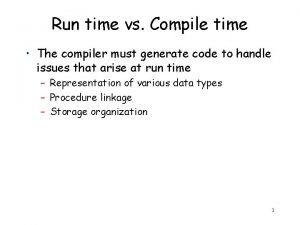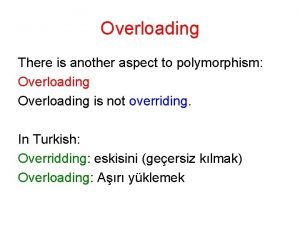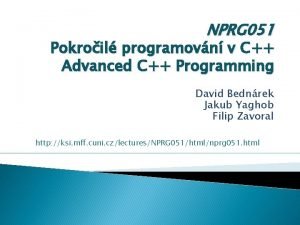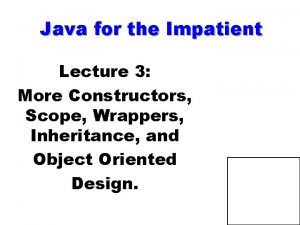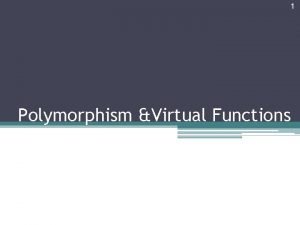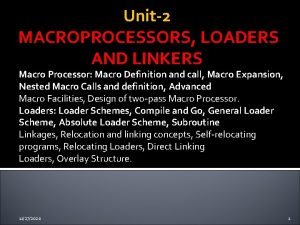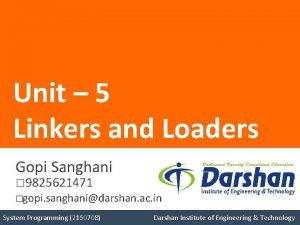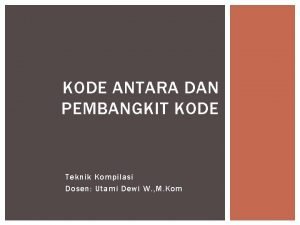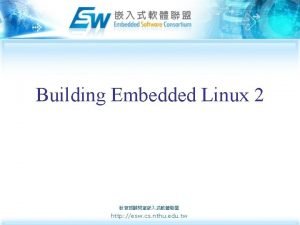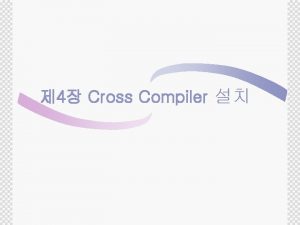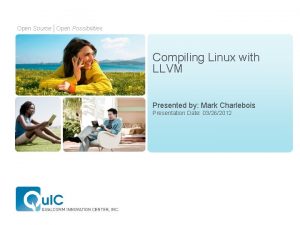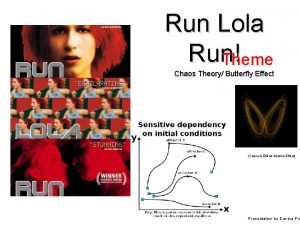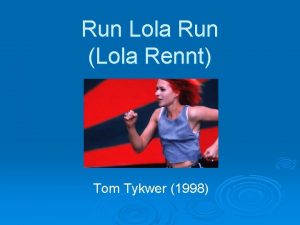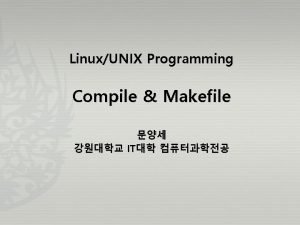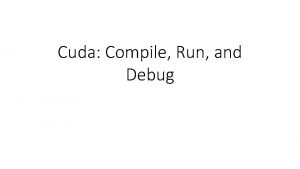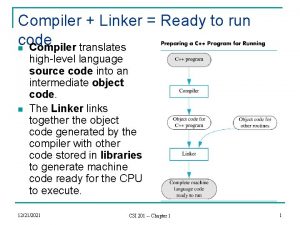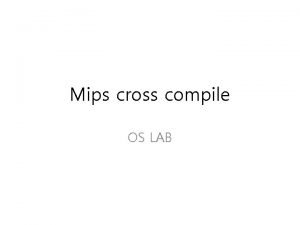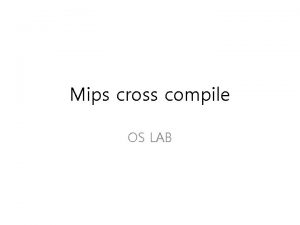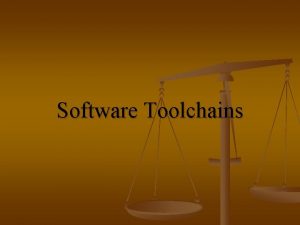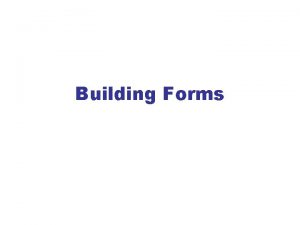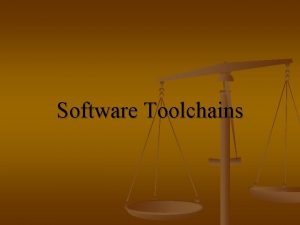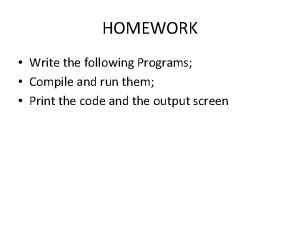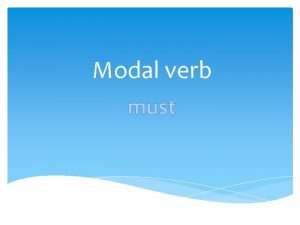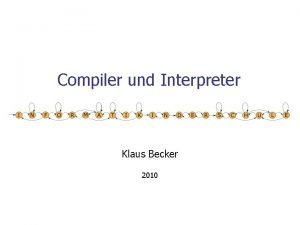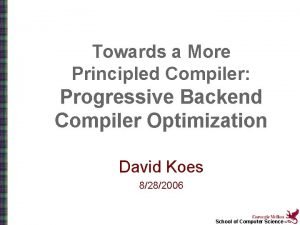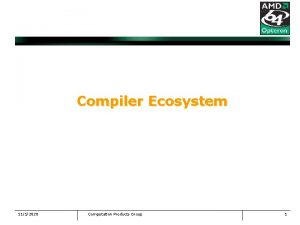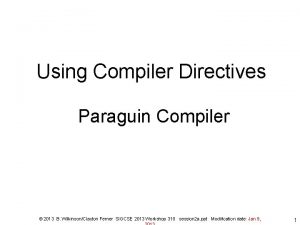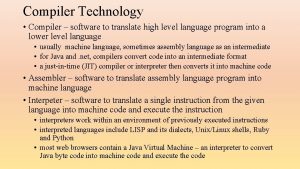Run time vs Compile time The compiler must
























- Slides: 24

Run time vs. Compile time • The compiler must generate code to handle issues that arise at run time – Representation of various data types – Procedure linkage – Storage organization 1

Data representation • Fundamental types are supported directly by machine operations • Enumerated types? • Booleans? • Arrays? • Strings? • Records? – packed – unpacked 2

Control abstraction • A procedure is a control abstraction – it associates a name with a chunk of code – that piece of code is regarded in terms of its purpose and not of its implementation. • Big issue #1: Allow separate compilation – – Without it we can't build large systems Saves compile time Saves development time We must establish conventions on memory layout, calling sequences, procedure entries and exits, interfaces, etc. 3

Control abstraction • Procedures must have a well defined call mechanism • In Algol-like languages: – a call creates an instance (activation) of the procedure – on exit, control returns to the call site, to the point right after the call. • Use a call graph to see set of potential calls 4

Control abstraction • Generated code must be able to – preserve current state • save variables that cannot be saved in registers • save specific register values – establish procedure environment on entry • map actual to formal parameters • create storage for locals – restore previous state on exit • This can be modeled with a stack – Allocate a memory block for each activation – Maintain a stack of such blocks – This mechanism can handle recursion 5

Name space • A procedure creates its own name space – It can declare local variables – Local declarations may hide non-local ones – Local names cannot be seen from outside. • The scope of a variable is the area in which it is active • Scope rules determine how declarations are mapped to names. 6

Storage allocation • Static allocation – object is allocated address during compile time – location is retained during execution • Stack allocation – objects are allocated in LIFO order • Heap allocation – objects may be allocated and deallocated at any time. 7

Static allocation • Objects that are allocated statically include: – – – globals explicitly declared static variables instructions string literals compiler-generated tables used during run time. 8

Stack allocation • Follows stack model for procedure activation • A procedure's memory block associated with an activation of the procedure is called an activation record or stack frame • Local variables are stored in the stack frame • The stack frame is pushed on the stack when the procedure is called and popped (and destroyed) when the procedure terminates • What can we determine at compile time? – We cannot determine the address of the stack frame – But we can determine the size of the stack frame and the offsets of various objects within a frame 9

Heap allocation • Used for dynamically allocated/resized objects • Managed by special algorithms • General model – – maintain list of free blocks allocate block of appropriate size handle fragmentation handle garbage collection 10

Scope rules • Static scoping – determined at compile time – Algol languages: resolve conflicts by using "closest nested scope" rule – We must come up with a mechanism to access enclosing scopes (later) 11

Scope rules • Dynamic scoping – depends on flow of control at run time – resolve conflicts using "most recently executed" rule – type checking deferred until run time – complicates program – any advantages? 12

Scope rules • Dynamic scoping example procedure main x, a: int; procedure one() begin x : = 1; end procedure two() begin x: int; one(); end begin x : = 2; read(a); if a>0 then one() else two(); print(x); end. run 1 : a is positive one() is called. The x in one() is bound to the most recent declaration which is the global one. The global x is given the value of 1 and the program prints 1 in the end. run 2 : a is negative two() is called. It declares a local x. Then it calls one(). The x in one() is bound to the most recent declaration which is the local declaration in two(). That local x is given the value of 1. one() exits. two() exits and the local x dies. The global x is still 2. The program prints 2 in the end. 13

Scope rules • Dynamic scoping -- why bother? – It allows us to customize procedures. • Consider a procedure print_integer that can print its argument in base 8, 10 or 16. Furthermore, we usually want to print it in base 10. We can use a global variable (such as x in the example) which is set to 10. Then, if we want a different base, we can declare a local x, set it to 8 or 16, and call print_integer. Once we exit the current scope, the local x dies and we are back to the default value. – Is there another way to do this? • Yes, we could have passed x as a parameter • Yes, we could have made x a statically allocated variable (e. g. global), initialized it to 10 and, if necessary, reset its value right before and after a call to print_integer – bad idea: we might forget to restore it after the call. 14

Storage organization • Stack layout – each procedure is given a stack frame at the top of the stack – stack grows towards lower addresses – at any time the stack pointer points to the current top of the stack (first available location) – at any time, the frame pointer points to the beginning of the current frame – the stack frame size and the offsets are determined at compile time! – stack frame contents are accessed as offsets relative to the stack pointer or frame pointer • Do we need both? 15

Storage organization • Stack frames. What's in them? – – – – – arguments return value local variables temporary values stack pointer frame pointer return address dynamic link? static link? etc. 16

The stack frame • Dynamic link = – a reference to the frame of the caller – needed to be able to restore the stack – can we use it to access non-locals? • Some languages allow nested procedures – In order to implement the "closest nested scope" rule we need access to the frame of the lexically enclosing procedure – Example: A() { B(); C(); } • C can call B, but B is lexically enclosed in A 17

Handling nested procedures • Method 1 : static (access) links – Reference to the frame of the lexically enclosing procedure – Static chains of such links are created. – How do we use them to access non-locals? • The compiler knows the scope s of a variable • The compiler knows the current scope t • Follow s-t links 18

Handling nested procedures • Method 1 : static (access) links – Setting the links: • if the callee is nested directly within the caller, set its static link to point to the caller's frame pointer (or stack pointer) • if the callee has the same nesting level as the caller, set its static link to point to wherever the caller's static link points to 19

Handling nested procedures • Method 2 : Displays – A Display encodes the static link info in an array. – The ith element of the array points to the frame of the most recent procedure at scope level i – How? • When a new stack frame is created for a procedure at nesting level i, – save the current value of D[i] in the new stack frame (to be restored on exit) – set D[i] to the new stack frame 20

Stack maintenance • Calling sequence : – code executed by the caller before and after a call – code executed by the callee at the beginning – code executed by the callee at the end 21

Stack maintenance • A typical calling sequence : 1. Caller assembles arguments and transfers control • evaluate arguments • place arguments in stack frame and/or registers • save caller-saved registers • save return address • jump to callee's first instruction 22

Stack maintenance • A typical calling sequence : 2. Callee saves info on entry • allocate memory for stack frame, update stack pointer • save callee-saved registers • save old frame pointer • update frame pointer 3. Callee executes 23

Stack maintenance • A typical calling sequence : 4. Callee restores info on exit and returns control • • • place return value in appropriate location restore callee-saved registers restore frame pointer pop the stack frame jump to return address 5. Caller restores info • restore caller-saved registers 24
 Runtime vs compile time
Runtime vs compile time Difference between compile time and runtime
Difference between compile time and runtime Nprg051
Nprg051 What are constructors in java
What are constructors in java Compile time polymorphism in c++
Compile time polymorphism in c++ Yet another compiler compiler
Yet another compiler compiler Cross compiler in compiler design
Cross compiler in compiler design What is a direct linking loader?
What is a direct linking loader? Reloctab
Reloctab Contoh soal ekspresi reguler
Contoh soal ekspresi reguler Compile code meaning
Compile code meaning Cvicats
Cvicats 크로스 컴파일이란
크로스 컴파일이란 Compile linux kernel with clang
Compile linux kernel with clang Long run equilibrium under perfect competition
Long run equilibrium under perfect competition Run lola run themes
Run lola run themes Run lola run editing techniques
Run lola run editing techniques Short run vs long run economics
Short run vs long run economics Within run and across run meaning
Within run and across run meaning Difference between short run and long run economics
Difference between short run and long run economics Brigitta olsen
Brigitta olsen Run lola run wiki
Run lola run wiki He must become greater i must become less
He must become greater i must become less Hình ảnh bộ gõ cơ thể búng tay
Hình ảnh bộ gõ cơ thể búng tay Frameset trong html5
Frameset trong html5
